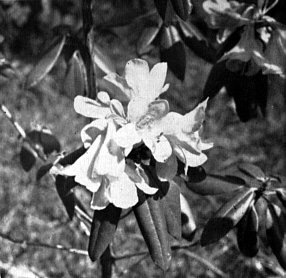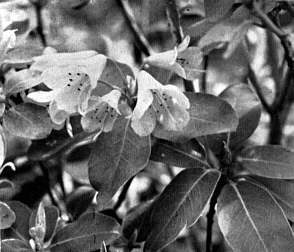QBARS - v12n4 The Re-creation of a Species
The Re-creation of a Species
By David G. Leach
Azalea enthusiasts will recognize the illustration on the front cover of this issue of the "Bulletin" as ' R. furbishii ', described as a new American species by W. P. Lemmon in 1941. The azalea pictured is ' R. furbishii ', but not as it is found in the wild. It is this same species, re-created synthetically to demonstrate that it is not a valid species at all!
The azalea which was later named ' R. furbishii ' was discovered as a colony of about one hundred plants in Vogel State Park at Neel Gap, Georgia in 1934. After seven years of observation and study, according to Lemmon, he described it as a new species (in Bartonia 21: 5-6, 1950-41).
In 1948 I had an opportunity to examine the handsome pink-flowered plants for the colony described by Lemmon. It seemed to me that they were probably early generation hybrids between arborescens and bakeri . As I speculated about their origin on subsequent occasions my interest was further aroused and in 1952 I determined to satisfy my own curiosity by proving or disproving my theory.
I crossed bakeri with arborescens under controlled conditions in an effort to duplicate ' R. furbishii ' as it was found in Georgia. The characteristics of my hybrids and those given by Lemmon in his original description offer the following comparison:
| ' R. furbishii ' | R. arborescens x R. bakeri | |
| Corolla | Lobe edges shell pink, upper lobe with large orange blotch. | Same |
| Upper Lobe | 15 mm. wide x 21 mm. long | Same |
| Laterals | 12 mm. wide x 21 mm. long | 12 mm. wide x 23 mm. long |
| Lower Lobes | 12 mm. wide x 21 mm. long tips recurving, edges revolute | 12 mm. wide x 26 mm. long Same |
| Corolla Tube | 2 to 2.5 cm. long to beginning of expansion, strongly ridged, pubescent and eglandular within, exterior viscid, pubescent and with some glandular hairs. | 2 cm. long, otherwise the same |
| Corolla Hairs | Tipped with white glands. | Same |
| Filaments | White, pubescent at base, carmine above. | Same> |
| Anthers | Deep orange | Brown |
| Style | Carmine, pubescent at base only. | Same |
| Stigma | Dark carmine. | Purple |
| Ovary | Densely pubescent with long hairs. | Same |
| Pedicel | Eglandular. | Same |
| Calyx Lobes | Unequal, ciliate, base strigillose and eglandular. | Same |
| Twigs | Glabrous, or with occasional hair. | With occasional hair. |
| Petiole | 2-4 mm. long, strigillose, channeled above, edges pubescent, long hairs. | Same |
| Leaf Blade | Elliptic, gland-tipped, veins impressed, midrib strigillose and pubescent, strigillose beneath. 3-6 cm. long, 1.5-3 cm. wide, light green, glaucescent beneath. | Same, edges ciliate. 3-5.5 cm. long, 1.3-2 cm. wide, light green, variably green to glaucescent beneath in different seedlings. |
The hybrid plants produced from my cross, now six years old, are almost identical with those described in the wild by Lemmon. They could be added to the colony at Vogel State Park in Georgia and no botanist could distinguish them from the indigenous population. Both bloom at the same time. Both exhibit the same flat-topped, heavily branched growth habit and rather low stature.
One of many conspicuous differences between the white-flowered arborescens and the red-flowered bakeri is in the twigs, the former being naked and smooth, the latter bristly. Both ' R. furbishii ' and my own synthetically produced hybrids are intermediate between the two parents in this characteristic, as they are in flower color and in many other respects.
The evidence on a genetic basis is conclusive: ' R. furbishii ' is a hybrid, and it is probably not even an advanced generation hybrid, but the first offspring of a simple natural cross in the wild between arborescens and bakeri .
At the time the controlled cross was made at my trial grounds between the two species in 1952 I hoped for a duplication of ' R. furbishii ' but I could not be certain that this bit of genetic detective work would produce such clear and final evidence. I arranged therefore to get self-pollinated seeds from the wild plants in Georgia. I expected the plants they produced to provide supporting evidence for my theory.
Such an expectation was based on the fact that plants in nature in an isolated group become more and more alike with the passage of time until finally each generation is a duplicate of the preceding and a stable species evolves which retains its identity as it reproduces itself. But early generation hybrids do not "come true" from seeds. They betray their forebears by producing offspring exhibiting the characteristics of their progenitors in various clear combinations.
This describes exactly the plants produced from the self-pollinated seeds of ' R. furbishii .' Some of the characteristics of arborescens and of bakeri even appeared among the seedlings in the classic segregating proportions. Flower color ranged from true bakeri red to arborescens white, with larger numbers intermediate pinks, many of which are of unusual ornamental value, A few plants have white flowers with a yellow blotch on the upper lobe contributed by bakeri , suggesting that this is probably the origin of the blotched arborescens which has been proposed as a distinct variety of the species or even as a separate species. There are a few plants with interesting ivory, buff and amber-colored flowers similar to occasional specimens which can be seen in the North Carolina mountains.
In vegetative characteristics the variation is equally complete, minor proportions of the seedlings exhibiting the extremes of the dissimilar parents and larger numbers showing modification imposed by interaction of the two genetic heritages.
The re-appearance of bakeri -like and arborescens -like plants together with a range of intermediates in the offspring of ' R. furbishii ' makes doubly final the conclusive evidence obtained from the other experiment. ' R. furbishii ' is not a valid species as described by Lemmon and accepted by Hume and others. Its hybrid status has been clearly proved.
The general tendency of botanists not to recognize the scope and scale of natural hybridity among American azaleas in the wild has been all but universal. In his description in Bartonia , Lemmon even mentions that "plants showing hybridism with A. arborescens were found nearby..." but still he concluded that the colony of distinct plants first found in 1934 constituted a new species.
The American azaleas have been sporadically studied by amateur naturalists and by professional botanists since about 1690. In relation to their importance in the region and their influence on our horticulture the observations are limited in number and generally superficial in character. Only a few of the published studies make any reference to natural hybrids and most of those only in the most tentative and timid manner, yet hybridity is the most conspicuous single feature of the entire Azalea population of our Southern mountains. Those who glibly ascribe omniscience to earlier observers are either ignorant of the literature or lacking in historical perspective. Even the most recent studies, by such researchers as Skinner and Galle, have only begun to dispel the "marked limitations of our present knowledge of the botany, genetics or even geographic distribution of the native (azalea) species."
A review of the material published on the American azaleas fails utterly to give any real conception of the enormous scale on which hybridity exists. No comprehensive study of the vast hybrid Azalea populations has yet been made, though their existence has at least been recognized and recorded by several observers, and more work is under way.
The magnitude of azalea hybridity in the Southeast naturally leads to speculation about the validity of Asian rhododendron species. From observations made in the preparation of my book on rhododendrons I believe there is evidence to suggest that numerous rhododendron species from the Orient are no more entitled to specific distinction than is ' R. furbishii .' The Triflorum, Neriiflorum and Lapponicum series and the Roxieanum subseries are in chaotic condition with respect to the definition of the species in them, and the criteria by which they are purported to be recognizable. Elsewhere, some groups of allied species serving as links between others more sharply defined give evidence of themselves being natural hybrids recently evolved, and it may yet be determined that these entire series are no more than early generation progeny of accidental crosses in the wild. I am convinced that R. concatenans (Fig. 41) and xanthocodon , (Fig. 42) for example are merely two more in the swarm of varieties and natural hybrids all of which should constitute the species we call cinnabarinum .

|

|
|
Fig. 41.
R. concatenans
R. Henny photo |
Fig. 42.
R. xanthocodon
R. Henny photo |
I suggest that rhododendrons are especially in need of study by geneticists and that our knowledge of them could thus be enormously expanded. The American Rhododendron Society might take the lead in securing financial support from one of the foundations for such a project, which could easily result in an important scientific contribution. The field collectors and botanists who have observed rhododendrons in their native habitats have been oriented toward the viewpoint of the systematist, who is trained to see resemblances among plants, and hybridization in the wild, which is primarily repeated backcrossing of natural hybrids with the original plant population, produces offspring which closely resemble the recurrent parent. Geneticists, on the other hand, are trained to see differences , and to search for those that may even be minute, as they seek to unravel the tangled skeins which lead back to the origins of plants obscured by the tides of time.
